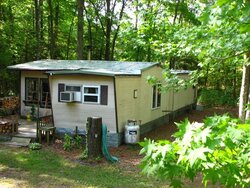Also known as "the hole I throw money into..."
Okay, so. I live in a 30 year old mobile home. It's got your standard flat tin roof over particle board. Last winter, it started leaking around the base of my wood stove chimney. I got a tube of the roof tar sealant stuff and coated it to hell and gone, and that seemed to do the trick, but when my stove guy was out here cleaning it, he said I should really look into replacing the roof.
I called contractor after contractor and no one wants to work on an old mobile home, there would be too many possible structural weaknesses and they don't want to be on the line if my roof caves in. Our homeowner's insurance doesn't cover this kind of repair (but will pay for the roof caving. Go figure, you think fixing it BEFORE then would be cheaper...)
I've worked on shingled roofs before, just helping my dad patch things up after bad storms and stuff, but I don't have a clue what to do for a mobile home roof. I am not interested in ripping it off and starting over with shingles if we can possibly help it. The idea for the moment is to live cheap in this place for the next 5-8 years and then get the hell outta dodge.
I know there are several other mobile home owners. Ideas? Tips on how to make the all-consuming fire look like an accident that was in no way connected to my woodstove?
~Rose
Okay, so. I live in a 30 year old mobile home. It's got your standard flat tin roof over particle board. Last winter, it started leaking around the base of my wood stove chimney. I got a tube of the roof tar sealant stuff and coated it to hell and gone, and that seemed to do the trick, but when my stove guy was out here cleaning it, he said I should really look into replacing the roof.
I called contractor after contractor and no one wants to work on an old mobile home, there would be too many possible structural weaknesses and they don't want to be on the line if my roof caves in. Our homeowner's insurance doesn't cover this kind of repair (but will pay for the roof caving. Go figure, you think fixing it BEFORE then would be cheaper...)
I've worked on shingled roofs before, just helping my dad patch things up after bad storms and stuff, but I don't have a clue what to do for a mobile home roof. I am not interested in ripping it off and starting over with shingles if we can possibly help it. The idea for the moment is to live cheap in this place for the next 5-8 years and then get the hell outta dodge.
I know there are several other mobile home owners. Ideas? Tips on how to make the all-consuming fire look like an accident that was in no way connected to my woodstove?
~Rose



